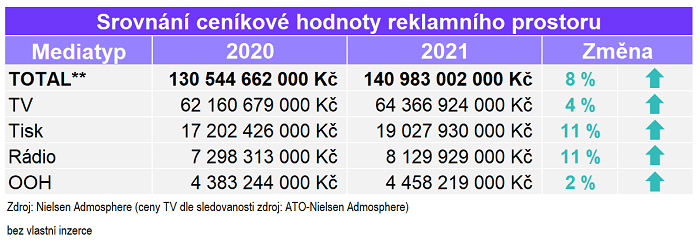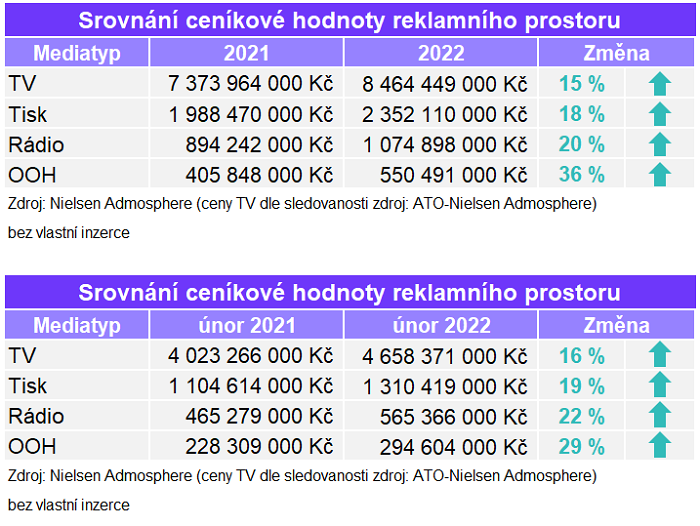The level of media literacy is generally increasing in Czech society. This is according to research by the Department of Media and Cultural Studies and Journalism at Palacký University in Olomouc and the STEM/MARK agency.
The level of media literacy in Czech society is generally increasing (39/100 points in 2018, 49/100 in 2021). This is according to a survey conducted by the Department of Media and Cultural Studies and Journalism at Palacký University in Olomouc and STEM/MARK for RRTV, which focused on the media literacy of Czechs. According to the researchers, the fact that the current younger generation has already grown up with new media, that the generation of the current forty-somethings has already grown up with the Internet, and that a wider range of media activities can be found among the oldest generation may have an influence.
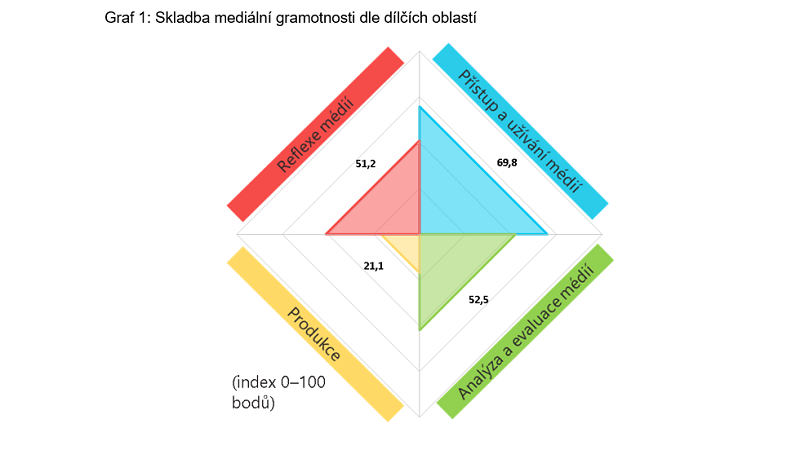
Source: Univerzita Palackého, STEM/MARK
The majority of media (as sources of information) are still trusted by the public (50 % or more). The exceptions are social media (35 % trust) and chain emails.
According to the survey, Czechs overwhelmingly support the view that the key issue (in terms of media use in general) is the safety of users and information about them. Nevertheless, they share the view that all information should be made public on the internet (59 %) rather than any regulation by law (35 %). Thus, the more liberal view of users, who still see the internet as a free sea, wins out in this respect. Liberality was also evident in the education of children and young people, where few parents restricted their children’s use of mobile phones, tablets or the internet.
The Czech population is mostly aware of what the public media are doing, and they can also recognise it. Only some considered Lidové noviny or Parlamentní listy to be public service media. The reason for this is likely to be the name of the media itself, which may refer to public service (this was shown in the aforementioned 2018 research).
Overall, university students, Prague residents and daily internet users performed significantly better in this area.
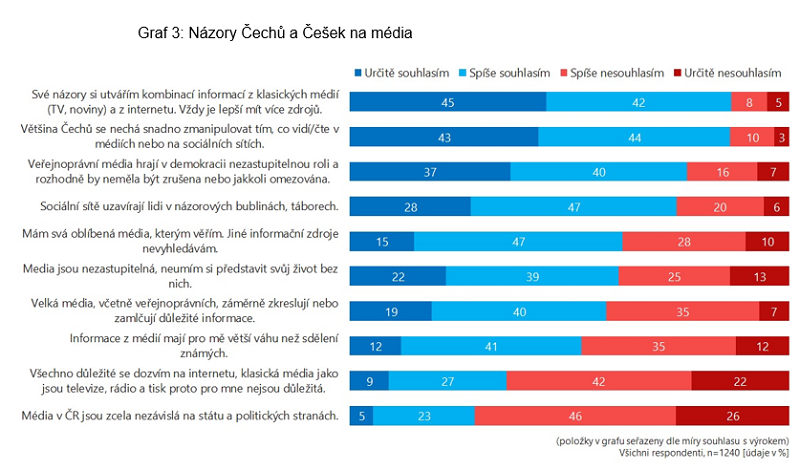
Source: Univerzita Palackého, STEM/MARK
According to the research, there are also more and more people who can identify fake news. Younger people under 30, university graduates, people from larger cities with over 100,000 inhabitants and people from Prague do better in recognizing fake news. In terms of preference for the type of news, preference is given to those that work with more verified sources and ideally contain commentary by an expert on the subject.
“The scope for improving the recognition of fake news is still greater among the elderly, who are often more trusting due to their different life experiences. However, thanks also to the work of many organisations, this situation has gradually improved over the last few years. The relatively positive result is probably related to the reaction to the increasing amount of fake news in the media space, where society, faced with the challenges of the epidemic or the Ukrainian crisis, is making efforts to ensure that the news about these events are accurate,” comments Jan Burianec from STEM/MARK on the results of the survey.
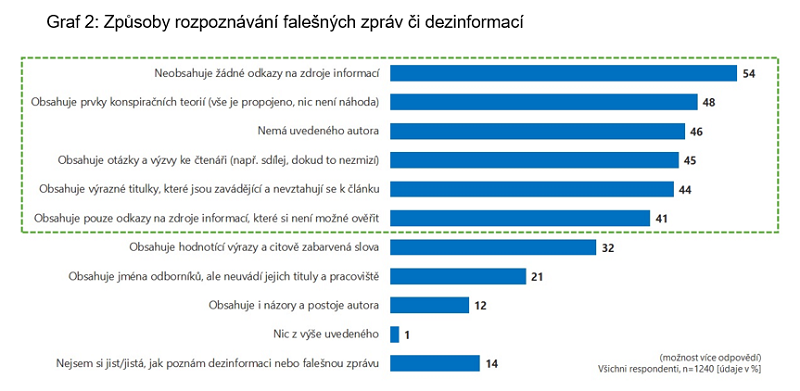
Source: Univerzita Palackého, STEM/MARK
Another measured area of research was self-production, i.e. the frequency and ways of contributing to the media space. Almost a quarter (23 %) of people consider themselves active media users (more often young people under 30 and students), while 71 % consider themselves passive (the remaining 6 % could not classify themselves). The most frequent activities include production on social media or other online platforms (sharing photos, stories or texts). The next one is writing user reviews of products or services (e.g. Heureka or Booking).
Self-media activity can also be helped by the perception that media offer sufficient opportunities for feedback to their consumers (in 2018, only a third of the population thought so). In parallel research with children and adolescents aged 5 to 15, it was found that own media creation is a frequent and popular activity from a relatively young age. “Teens from good socio-economic backgrounds manage their parents’ work profiles on Facebook or Instagram, for example, while those with lower socio-economic status present themselves on TikTok and look up to those who have a lot of followers and likes,” said Zdeněk Sloboda, the head of the entire research project from Palacký University.
The research divided the investigation of media literacy into four areas. One of them was technological literacy and user skills. Here the Czech population (15+) achieved the highest score (70 out of 100). The average score in this area was significantly higher for people under 45, slightly more often for men, people with higher education (high school diploma or university degree) and those who use the Internet on a daily basis. In general, people who use or combine multiple media types (media sources) do better. Conversely, the lowest scores were reported by those aged over 60 and non-users of the internet – these two groups overlap for the most part.
“There is still room for improving skills, especially among the elderly, where the epidemic crisis is leading to an increasing level of familiarity with modern technologies and the Internet,”
commented Jan Burianec.
A comparison of measured media literacy with its subjective assessment by the respondents themselves showed that in terms of socio-demographic profile, more men than women, more younger than older people and people who use the Internet more actively are considered to be more media literate. Although some of the respondents (with rather lower measured levels of media literacy) tended to overestimate or underestimate themselves in some cases (rather women and people with higher media literacy), for most people the extent of their knowledge and thinking about media corresponded with the measured values.
“We expected some variation; this is a classic example of cognitive bias. In practice, this means that people who perform poorly in a particular area, for example, tend to significantly overestimate their achievement when compared to others. This is known professionally as the Dunning-Kruger effect,” adds Jan Burianec.
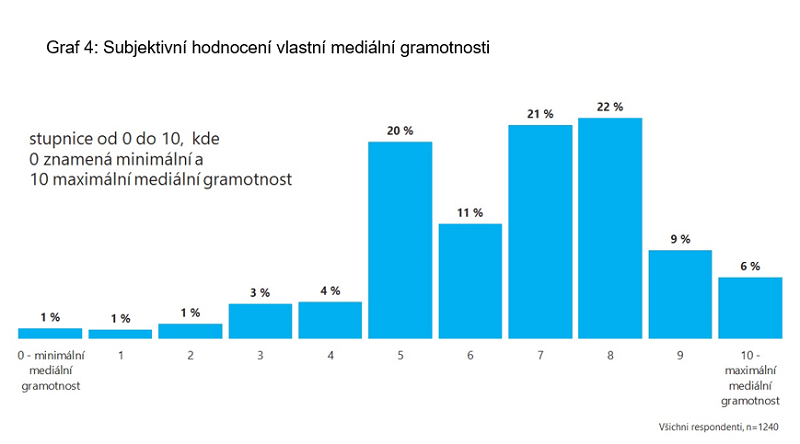
Source: Univerzita Palackého, STEM/MARK
About the research
Media literacy is understood in research as a concept that consists of four key components combining media and digital knowledge, skills and abilities:
■ Access to media technologies and how to use them in everyday life
■ Analysis and evaluation of media messages (critical thinking and reading)
■ Media production: understanding the processes of media production and the actual production of media content
■ Reflection on the functioning of the media and the perception of the role of the media in society (together with the ideas and values associated with the media and its use and products)
The research on the population aged 15 years and older was carried out using a questionnaire. For each area, scores (pass/fail, know/not know) were assigned to respondents through scored (knowledge or skill) questions. For a better comparison of the results, the total score by domain was budgeted into a 0-100 index, where 100 is equivalent to the maximum possible score in a given domain, and the minimum 0 is fixed. The research on the population under the age of 15 was conducted through a series of group interviews that took the form of workshops with various activities of a receptive, creative and discussion nature. The data was analyzed qualitatively in the four respective areas.
Passport – population over 15 years of age: The research conducted by STEM/MARK and Palacký University in Olomouc (KMKSŽ) for the Broadcasting Council was carried out by a combination of face-to-face (CAPI) and online interviewing (CAWI) and involved 1240 respondents from the Czech population over 15 years of age. The sample is representative in terms of quota selection by gender, age, education, size of place of residence and region. Data collection took place during September and October 2021.
Passport – population under 15 years of age: Palacký University, Department of Media and Cultural Studies and Journalism for RRTV conducted a series of 90-minute group workshops using the focus group method, involving various thematic and age-appropriate activities (media reception – watching a programme, production – producing one’s own media image, discussion – about media activities, over magazine advertisements or social media profiles). In the 5-7 age group, four group sessions were carried out with 38 children participating, in the 8-10 age group there were also four groups with 32 children and in the 11-14 age group three workshops were organised with 13 teenagers. In total, 83 children from different areas of the country and with different socio-economic backgrounds participated. Data collection took place during June to August 2021.
Source: mediaguru.cz



